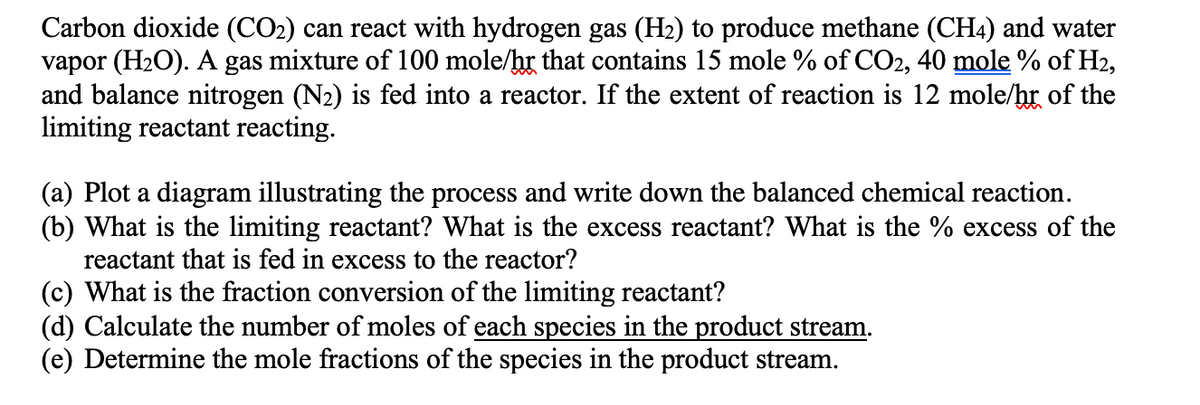Carbon dioxide (CO2) can react with hydrogen gas (H2) to produce methane (CH4) and water vapor (H2O). A gas mixture of 100 mole/hr that contains 15 mole % of CO2, 40 mole % of H2, and balance nitrogen (N2) is fed into a reactor. If the extent of reaction is 12 mole/hr of the limiting reactant reacting. (a) Plot a diagram illustrating the process and write down the balanced chemical reaction. (b) What is the limiting reactant? What is the excess reactant? What is the % excess of the reactant that is fed in excess to the reactor? (c) What is the fraction conversion of the limiting reactant? (d) Calculate the number of moles of each species in the product stream. (e) Determine the mole fractions of the species in the product stream.
Carbon dioxide (CO2) can react with hydrogen gas (H2) to produce methane (CH4) and water vapor (H2O). A gas mixture of 100 mole/hr that contains 15 mole % of CO2, 40 mole % of H2, and balance nitrogen (N2) is fed into a reactor. If the extent of reaction is 12 mole/hr of the limiting reactant reacting. (a) Plot a diagram illustrating the process and write down the balanced chemical reaction. (b) What is the limiting reactant? What is the excess reactant? What is the % excess of the reactant that is fed in excess to the reactor? (c) What is the fraction conversion of the limiting reactant? (d) Calculate the number of moles of each species in the product stream. (e) Determine the mole fractions of the species in the product stream.
Introduction to Chemical Engineering Thermodynamics
8th Edition
ISBN:9781259696527
Author:J.M. Smith Termodinamica en ingenieria quimica, Hendrick C Van Ness, Michael Abbott, Mark Swihart
Publisher:J.M. Smith Termodinamica en ingenieria quimica, Hendrick C Van Ness, Michael Abbott, Mark Swihart
Chapter1: Introduction
Section: Chapter Questions
Problem 1.1P
Related questions
Question
i need help with all the parts in this question asap

Transcribed Image Text:Carbon dioxide (CO2) can react with hydrogen gas (H2) to produce methane (CH4) and water
vapor (H2O). A gas mixture of 100 mole/hr that contains 15 mole % of CO2, 40 mole % of H2,
and balance nitrogen (N2) is fed into a reactor. If the extent of reaction is 12 mole/hr of the
limiting reactant reacting.
(a) Plot a diagram illustrating the process and write down the balanced chemical reaction.
(b) What is the limiting reactant? What is the excess reactant? What is the % excess of the
reactant that is fed in excess to the reactor?
(c) What is the fraction conversion of the limiting reactant?
(d) Calculate the number of moles of each species in the product stream.
(e) Determine the mole fractions of the species in the product stream.
Expert Solution
This question has been solved!
Explore an expertly crafted, step-by-step solution for a thorough understanding of key concepts.
This is a popular solution!
Trending now
This is a popular solution!
Step by step
Solved in 4 steps with 1 images

Recommended textbooks for you

Introduction to Chemical Engineering Thermodynami…
Chemical Engineering
ISBN:
9781259696527
Author:
J.M. Smith Termodinamica en ingenieria quimica, Hendrick C Van Ness, Michael Abbott, Mark Swihart
Publisher:
McGraw-Hill Education

Elementary Principles of Chemical Processes, Bind…
Chemical Engineering
ISBN:
9781118431221
Author:
Richard M. Felder, Ronald W. Rousseau, Lisa G. Bullard
Publisher:
WILEY

Elements of Chemical Reaction Engineering (5th Ed…
Chemical Engineering
ISBN:
9780133887518
Author:
H. Scott Fogler
Publisher:
Prentice Hall

Introduction to Chemical Engineering Thermodynami…
Chemical Engineering
ISBN:
9781259696527
Author:
J.M. Smith Termodinamica en ingenieria quimica, Hendrick C Van Ness, Michael Abbott, Mark Swihart
Publisher:
McGraw-Hill Education

Elementary Principles of Chemical Processes, Bind…
Chemical Engineering
ISBN:
9781118431221
Author:
Richard M. Felder, Ronald W. Rousseau, Lisa G. Bullard
Publisher:
WILEY

Elements of Chemical Reaction Engineering (5th Ed…
Chemical Engineering
ISBN:
9780133887518
Author:
H. Scott Fogler
Publisher:
Prentice Hall


Industrial Plastics: Theory and Applications
Chemical Engineering
ISBN:
9781285061238
Author:
Lokensgard, Erik
Publisher:
Delmar Cengage Learning

Unit Operations of Chemical Engineering
Chemical Engineering
ISBN:
9780072848236
Author:
Warren McCabe, Julian C. Smith, Peter Harriott
Publisher:
McGraw-Hill Companies, The